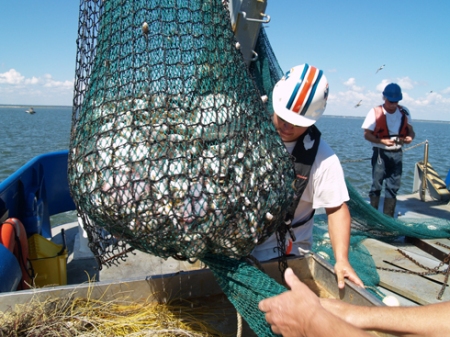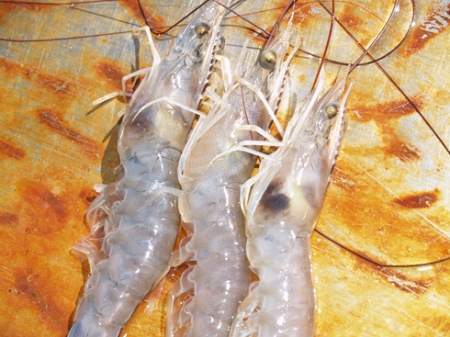Posts Tagged ‘plankton’
Tiny but voracious marine organism studied — video
February 8, 2017Tiny but all-consuming marine organism focus of UGA Skidaway Institute study
February 8, 2017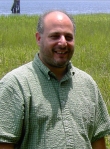
Marc Frischer
Doliolids are tiny marine animals rarely seen by humans outside a research setting, yet they are key players in the marine ecosystem, particularly in the ocean’s highly productive tropical and subtropical continental margins, such as Georgia’s continental shelf. University of Georgia Skidaway Institute of Oceanography scientist Marc Frischer is leading a team of researchers investigating doliolids’ role as a predator in the marine food web.
Doliolids are small, barrel-shaped gelatinous organisms that can grow as large as ten millimeters, or about four tenths of an inch. They are not always present in large numbers, but when they bloom they can restructure the marine food web, consuming virtually all the algae and much of the smaller zooplankton.
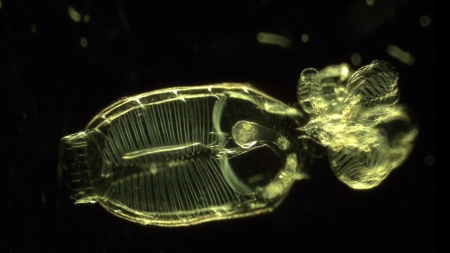
A doliolid with a cluster of juvenile doliolids on its tail. Actual size is approximately three millimeters, or one eighth inch.
“The goal of this particular study is to find out what the doliolids are eating quantitatively,” Frischer said. “This is so we can understand where they fit in the food web.”
Scientists know from laboratory experiments what doliolids are capable of eating, but they don’t know what they actually do eat in the wild. They are capable of eating organisms as small as bacteria all the way up to much larger organisms.
“What they are eating and how much are they eating from the smorgasbord that is available to them, that is the question,” Frischer said. “We are investigating how much of those different prey types they are really eating out there across the seasons.”
The project involves intensive field work, including 54 days of ship time on board UGA Skidaway Institute’s Research Vessel Savannah. During the cruises they conduct trawls using special plankton nets to collect the doliolids. They also collect water samples to understand the conditions where the doliolids thrive.
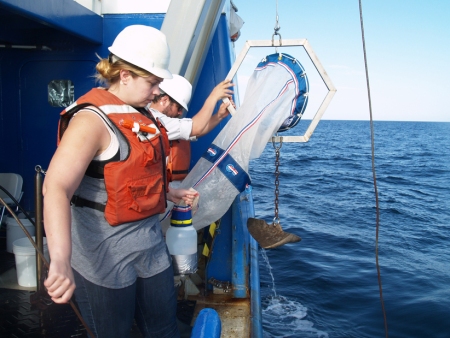
Graduate students Lauren Lamboley and Nick Castellane deploy a plankton net from the Research Vessel Savannah.
“We take the doliolids and the water samples back to the laboratory, and that is where the magic begins,” Tina Walters, Frischer’s laboratory manager said.
Because the animals are gelatinous and very delicate, the researchers cannot use classical microscopic techniques to dissect the animals and analyze their gut content. Instead they extract DNA from the animals’ gut and use sequence-based information to determine what the doliolid ate.
“We go through a process called quantitative PCR,” Walters said. “So even though we can’t see the prey in a doliolid’s gut, because the prey have unique DNA sequences, we can identify and quantify them using a molecular approach.”
The three-year project is funded by a $725,000 grant from the National Science Foundation and will run until February 2018. Frischer’s collaborator on the project is Deidre Gibson from Hampton University. Gibson received her Ph.D. from the University of Georgia in 2000, and did much of her graduate research at Skidaway Institute with Professor Gustav Paffenhöfer. In addition to Walters, Savannah State University graduate student Lauren Lamboley is part of the team, along with a number of students at Hampton University. Several undergraduate research interns have also participated in the project, gaining hands-on research experience. Frischer is also working with the Institute for Interdisciplinary STEM Education at Georgia Southern University to engage K-12 teachers by inviting them to participate in the research cruises.
New imaging lab in the news
January 23, 2017There was a nice article in Saturday’s Savannah Morning News regarding a new imaging lab at UGA Skidaway Institute.
http://savannahnow.com/news/2017-01-20/automated-microscopes-aid-crucial-ocean-work-skidaway
Cruising the North Atlantic in November
November 12, 2015Skidaway Institute researcher Elizabeth Harvey is one week into a five-week-long North Atlantic research cruise. Here is the latest post from the cruise blog, including a picture of Liz in the blue parka.
Cruisin’ with some great teachers
October 8, 2013Note: UGA Skidaway Institute professor Marc Frischer just completed a two-day cruise on board Skidaway Institute’s Research Vessel Savannah. The cruise was a mixture of science and education. We left the dock on Thursday evening, October 3, and cruised overnight to a station out on the shelf. Friday was spent hunting doliolids and other plankton. After returning the dock for Friday evening, we left again Saturday morning to collect samples for a project investigating the black gill disease (BGD) in shrimp. Both days were also part of the GK-12 teacher program, so we had a group of K-12 teachers with us both days. Marc Frischer wrote this account of the cruise. his main focus is on Day Two of the cruise on Saturday.
Just a quick summary of our small shrimp Black Gill Disease survey we completed on Saturday 5 October.
The trip went very well. We had quite an interesting roster of cruise participants. We only ended-up with 3 teachers, but two of them brought a child.
We had 6 teachers on the offshore leg during the previous days, but I think I wore them out. The ones we had left were pretty die-hard and very enthusiastic. This is a comment one of the teachers aboard (Joy McCook, Bradwell Institute) posted on her Facebook page in response to one of the comments she received after posting a bunch of her phots
“It was amazing! Thank you so much Marc E Frischer! Kaylee had to tell everyone about all the cool stuff she did and saw today. I already have so many ideas in my head of how to pull the fellows research into my class and it has given my new possible lab ideas! I also loved meeting the new teachers and seeing the others one again. The crew was so AMAZING! Thank you so much for extending the invite.”
Also aboard from UGA Marine Extension Service were Lindsey Parker and John Crawford (Crawfish). Mickey Baxley was also aboard but was filling in for crew on the R/V Savannah. I also had several of my lab members along and Mike Sullivan (Skidaway Public Relations) was along taking pictures and video.
We started the cruise with a bit of a lecture and discussion about Black Gill Disease and our mission for the day. It was a lively discussion and was fantastic to have so many different perspectives in the room.
Using the R/V Savannah we took replicate (2x) 15 min trawls just off of Wassaw Island just past the line of demarcation (offshore), in Wassaw Sound (in the Salt Pond area), and in the Wilmington River.
In general we didn’t catch very many shrimp. In the offshore tows we managed to catch 1 animal. It was a large male and did not have BGD.
But in the Sound and River we caught a bit more. We counted and examined a total of 113 shrimp in the Sound trawls and 210 animals from the River trawl.
The incidence of BGD was pretty high and was similar in the Sound and River. BGD infection rates ranged from 60-70% of the catch and 26-29% of those exhibited severe infections. A comparison of males to females suggested that females were more likely to be infected than males, but this data is a bit skewed because we caught mostly females. Approximately 70% of the catch was female in both the River and Sound trawls.
We collected and kept alive 20 shrimp with BGD and 20 that did not seem to have BGD (though I suspect they all do to some degree). These we transferred to holding tanks at SkIO and will do transmission studies with them next week. The first priority will be to look at transmission from heads of shrimp with BGD.
We also collected samples for DNA analysis.
That’s about it. If anyone wants the data I’ll be happy to share it.
Here is a tentative schedule of events for Skidaway Marine Science Day
September 24, 2012Skidaway Marine Science Day
Saturday, October 20, 2012
Noon to 4 p.m.
- Jay Wolfe Nature Trail, Interpretive Cabin, Interpretive Gardens (Open at 10 a.m.)
- University of Georgia Aquarium Open – Free Admission
- “Ossabaw” the Loggerhead Sea Turtle on display (Aquarium)
- Touch Tanks (Aquarium)
- Behind the Scenes peeks at the UGA Aquarium. Every 10 minutes. Maximum of 15 visitors at a time. Children under 18 must be accompanied by an adult. Line up at back aquarium door.
- Environmental Group Exhibits (Skidaway Institute Quad)
- Tours of Research Vessel Savannah (Skidaway Institute Dock)
- Plankton World (Marine and Coastal Science Research Center)
- Build a Plankton (Tent outside the Marine and Coastal Science Research and Instruction Center)
- Science Exhibits (Skidaway Institute Quad & R/V Savannah)
- Microbe Hunt – Grab a swab and find the microbes in the world around you. (Skidaway Institute Quad)
- Gray’s Reef ROV Activity (Skidaway Institute Quad)
- Oyster Reef Restoration Displays and Activities (Shellfish Lab Patio)
- Habitat Explorations “Oceans” (Aquarium Day Group Room)
- Habitat Explorations “Plankton” (Aquarium Plankton Lab)
- Habitat Explorations “Tidal Creeks” (Aquarium Invertebrate Lab)
- “Marine Debris” (Aquarium Art Lab)
- Crabbing on the Dock 1-3 p.m. (UGA Marine Extension Service Dock)
- The Savannah Blood Alliance Blood Donation Drive (Aquarium Parking Lot)
- Door Contest: Visitors can enter their name in a drawing for a Free Season Family Pass to the Aquarium. Sign up at front desk in Aquarium Lobby.
- Radio Broadcasting – Adventure Radio Group
SCHEDULED EVENTS
12:15 PM — Fish Feeding (Aquarium)
12:30 PM – “Bridges and Bulls: A history of Skidaway Island” A talk and walking tour by Dr. Bill Savidge
1:00 — Shark Dissection with Curator Devin Dumont (Aquarium Invertebrate Lab)
12:30 PM – Plankton Sink- Off Preliminary Round (Tent outside Marine and Coastal Science Research and Instruction Center)
1:30 PM – “What are scientists talking about?” A series of short talks by Skidaway Institute scientists on current research and issues in marine science. – McGowan Library Auditorium
1:30 PM – Plankton Sink Off Preliminary Round (Roebling House)
1:50PM — Fish Feeding (Aquarium)
2:00PM — Reptile Show with John “Crawfish” Crawford, Marine Educator (Screened porch.) – Gators, snakes, turtles, and lizards, OH MY! Develop a greater understanding of some of the most amazing vertebrates found along the Georgia coast.
2:30 PM – Plankton Sink Off Preliminary Round (Tent outside Marine and Coastal Science Research and Instruction Center)
2:00 PM – Skidaway Island History Talk and Tour by Dr. Bill Savidge (McGowan Library Auditorium)
2:30PM — Behind the Scenes Tour (Aquarium)
2:30 PM – Plankton Sink Off Preliminary Round (Tent outside Marine and Coastal Science Research and Instruction Center)
2:50 PM — Fish Feeding (Aquarium)
3:00 PM – Georgia Sea Turtles with John “Crawfish” Crawford, Marine Educator (Screened Porch) – Join in this fun and exciting know all about sea turtles, especially the ones that use Georgia beaches as nesting sites.
3:30 PM – Plankton Sink-Off Final Round (Tent outside Marine and Coastal Science Research and Instruction Center)
Participating Environmental and Educational Groups
- Georgia DNR-CRD
- Gray’s Reef National Marine Sanctuary
- The Dolphin Project
- Savannah National Wildlife Refuge
- Georgia Sea Turtle Center
- Tybee Marine Science Center
- Sierra Club
- Skidaway Island State Park
- Georgia DNR – Law Enforcement
- Georgia DNR – Underwater Archaeology
- Savannah State University Marine Sciences Department
- Armstrong Atlantic State University Diamondback Terrepin Project
- Youth for a Cleaner Environment
Berger’s co-authors paper in Marine Biology
September 10, 2012 Stella Berger is one of the co-authors of a paper published recently in the journal, Marine Biology. The project studied the effect climate change has on the timing and magnitude of spring plankton blooms in both fresh- and saltwater ecosystems.
Stella Berger is one of the co-authors of a paper published recently in the journal, Marine Biology. The project studied the effect climate change has on the timing and magnitude of spring plankton blooms in both fresh- and saltwater ecosystems.
The entire paper can be accessed at: http://www.skio.usg.edu/aboutus/people/nejstgaard/downloads/Winder-Berger.pdf
A Day in the Life of a Citizen Scientist
June 21, 2012Skidaway Institute volunteer scientist Nancy Tenenbaum recently travelled to Norway, to work with fellow Skidaway scientist Dr. Stella Berger. She described her experience in the form of a letter to her mentor, retired Savannah business leader and Skidaway Institute supporter, Howard Morrison.
Dear Howard,
Having had a few days to settle in here and wishing I could have packed you in my suitcase as well. I am going to let you share the day with me through this letter. I am in Espegrend, Norway, with a phytoplankton research project called Phytostress. The word “stress” takes on a new meaning with this project. There are only a hand full of students and professors here to manage twelve mesocosms and three experiments. In the course of the next two weeks I know I will need your encouragement and advise.
Rule #1 is “NEVER give up”. Howard Morrison
So, let the day begin.
7:00 AM
Taped to the window in my dorm room is a thick, black garbage bag to keep out the midnight sun. Light at any hour after 10 pm is your worst enemy! Block it out at all costs. You might find it a bit challenging to navigate in my tiny dorm room. Most certainly it is not the spacious Civil War home, Lebanon Plantation, that you reside in. Through an open window in the kitchen field station birds sing incessantly. Fresh coffee waits patiently for the early riser made by Maria Segovia, the principal investigator of Phytostress. Norway has no version of half and half cream. Flotte,, heavy cream., is it. Putting a small amount in my coffee cup I think about the potential threat for artery clogging. Will I survive the day? On the wooden counter top a Norwegian breakfast of various cheese, lox, fruit muesli and a hardy multi-seed rye bread await.
7:30 AM
You will need a jacket this morning as it is cool, about 11 degrees C (52 degrees F). The fiord water sparkles in the sunlight. On the hillside edelweiss, purple clover and yellow buttercups dance with the morning breeze. Compared to the weather when I was here in March, this is heaven.
Let me explain this project to you using an abstract provided by Maria Segovia, the principal investigator, for Phytostress:
Under the global change scenario around 40-50% of the CO2 emitted by anthropogenic activities is accumulated in the oceans causing acidification and increasing the availability of dissolved CO2 to primary producers (phytoplankton, algae, etc.). To understand the regulation of the carbon cycle it is basic to determine the interaction of the main factors controlling primary production in the ocean. The increase of UV radiation due to ozone loss can reduce the oceanic phytoplankton CO2 sinking capacity up to 2%. Concomitantly, the scarcity of micronutrients, such as iron, can affect the composition, functioning and growth of phytoplankton. However, although up to date there are several studies about the effect of UV on iron ocean speciation, there is none about the interaction between CO2, Fe (iron) and UV in phytoplankton, and the underlying mechanisms has not been elucidated yet. Equally, there is evidence of massive cell death phenomena in phytoplankton communities that can account for a great loss of biomass amount, altering diversity and hence affecting the carbon cycle. The proposed experiments, will lead us to a better understanding about the functions of marine phytoplankton as well as to determine how changes in CO2, UV and Fe availability control the fate of primary production in the ocean, regarding biomass and diversity loss.
In an introductory email before the research in May, Maria wrote that this mesocosm project is a dream come true for her.
8:45 AM
Howard, we are now at the dock. I know how much you love to ride in boats. Even though the ride to the raft will be quick it could be chilly. The swans that graced the fjord in March are gone. Truthfully they were noisy, mean and not very white, like their counterparts in fairy tales.
Scientists and Ph.D. students, who are scheduled to sample water today, gather at the dock with sixteen, 25-liter carboys. Clothed in Healy Hansen immersion suits or only a life jacket they board small motorboats for the mesocosms.
You are now at the mesocosm raft. Be careful on exiting the boat as the concrete raft moves with the current making its surface slippery. There are twelve covered mesocosms that are tethered to this raft. A decoy hawk is mounted on a pole to scare off birds. It does absolutely no good! Birds actually seem attracted to it. Water is sampled by pumping H2O though a plastic meticulously washed tube into carboys. Full carboys of 25 liters are then loaded onto the boats, delivered to land and hauled up a hill using a flat wagon and human strength.
THE MESOCOSMS
We are about to enter the lab when I spy a single wild yellow rose in full bloom. Immediately I am reminded of Antoine de Saint-Euprey’s story, The Little Prince. In this children’s book the rose is essential to the novel’s drama. Carefully tended by the prince, she is his motivation for leaving and returning to his planet. The rose in this book represents love, an invisible but essential emotion. If no passion exists to nourish life then the question presented is: can life survive? My passion extends to the invisible life of phytoplankton. They are in fact the unseen art forms. Simple, yet complex their balance in the food web is essential for life.
Howard, you often sign your emails with the quote: “Only those who can see the INVISIBLE can accomplish the IMPOSSIBLE!” Patrick Snow, Author, Creating Your Own Destiny
Armed with those words, I will take you into the lab hoping to have a productive day.
Actually the lab rooms are right out of Dr. Seuss! Wacky and wonderful the equipment is dormant waiting for creative direction. Machines hum and filtering systems wait expectantly. Life in the lab is a clandestine life unto itself.
We will need to double glove for this next task. An elaborate washing protocol is the first order of duty. Each sampling bottle must be washed with Deacon water, then immersed and soaked in HCl and finally rinsed five times with Milliq. H2O. As this involves a Fe (Iron) limitation experiment it becomes imperative to remove all possible traces of containment iron. This is a very time consuming process.
10:30 AM
Dr. Stella Berger and I are on the microzooplankton team. Microzooplankton can be defined as greater that 0.2-20 micrometers in size, which includes ciliates, dinoflagellates and diatoms. She is also working on a dilution experiment that she designed.
We return to the boat with Dr. Jose Fernandez from Malaga, to sample mesocosms numbers 1-6 and the fjord. Our samples are brought to our cold room. Part of every sample is then labeled and stored in covered boxes. Some are viewed as live slides in the inverted microscope. This is my favorite part of the day. Seeing the phytoplankton move and interact is just amazing. When I was here in March, I had the rare opportunity to meet and work with Andrei Sazchin. Dr. Sazchin is a Russian phytoplankton taxonomist.
Stella begins running her samples through a Flow Cam. Every cell is photographed and organized into libraries for later study. Each mesocosm sample involves a thirty-minute run process.
1:20 PM
I have a brief SKYPE conversation with my mentor and close friend, Sandra Nierzwicki-Bauer, Director of the Darrin Fresh Water Institute at Bolton Landing, Lake George, New York.
It does fact take a village of mentors to maintain the privilege of representing Skidaway Institute as a citizen scientist. Dr. Marc Frischer and Dr. Stella Berger are also instrumental in guiding me on scientific path.
2:30 PM
Lunch. I am the only American here. The Spanish lunch have a late, protracted lunch experience. This long, heavy lunch is followed by lengthy scientific discussions in Spanish.
3:00 PM
Hope you are ready for a quick refreshing walk. The path by the fjord is a perfect place to reflect and regenerate. Bergen is a dichotomy. Look beneath the perfect postcard landscape and you will discover an ugly history of Nazi infiltration, which happened during WWII.
On the hillside adjoining the field station is the “castle.” A Nazi once owned and lived in this forbidding residence. Inside, according to the locals, are memorabilia including swastikas that cover the walls. Just looking upon it reminds me that six million Jews died as a result of Hitler.
Turning back to the water we are accosted by the smell of wild roses and rhododendron. Seagulls cry. The sound of the water is soothing as it covers rocks and sand on a small beach. Tiny islands with houses dot the fjord. You can feel the ancient pulse of the land. It emanates from the soil. Life despite its brief encounter with chaos and death has moved forward in a beautiful, peaceful way.
3:45 PM
Back in the lab we are ready to take the sample water for chlorophyll a (Chl a) is filtering in duplicate. The lights are turned off and sunlight blocked by a makeshift shade as it excites the chlorophyll. A reading skewed by light will not be accurate. Once the water is filtered, the filter is put in a falcon tube, extracted with 90% acetone and then put in a covered box in a refrigerator where they stored for 6-24 hours. The next day samples are measured by a fluorometer. This device measures parameters of fluorescence determining the amount of Chl a in the sample.
5:00 PM
We are back at a hood with an exhaust fan. After we have double gloved, each bottle will be immersed in hydrochloric acid for two hours.
6:00 PM
At some point every day it is good protocol update a lab notebook with general thoughts and data for the day.
7:00 PM
Stella has just finished running the last sample in the Flow Cam. Slides from the inverted microscope used during the day are carefully washed.
7:30 PM
Dr. Jose’ Fernandez, Armando Olmo and I are on cooking duty tonight for 16 hungry people. You can pour the wine Howard to keep us happy while we cook. Tonight we will prepare paella. a traditional Spanish dish. This is a secret recipe of Jose’s grandmother. I am chopping vegetables and hoping to learn the recipe for this famous meal. What I did manage to get from Jose’ is that the rice must absorb the flavors of the meat and vegetables. Timing apparently is everything. So thanks to Jose the paella was delicious and a great success.
10:00 PM
The scientist and students sit down for dinner at a long narrow wooden table which seats at least 25. Most of the conversation is in Spanish. Some students go back to the lab after dinner to finish up.
11:30 PM
Howard, there is something about the Norwegian blue hour that is pure magic.
The blue hour, not quite at sunset, floods the landscape with a purplish blue hue. Maria’s two children are still running around with abundant energy. Laughing, and singing they are so undeterred by the hour. I on the other hand am jet lagged and exhausted. From my room I hear Maria’s husband calling his son Rodrigo to come inside.
Thanks for sharing the day with me!
Good night from the land of the midnight sun.
With love,
Nancy Tenenbaum –Citizen Scientist, Skidaway Institute of Oceanography
Skidaway campus open house a success!
October 13, 2009We had a great open house on Saturday. Close to 2,000 braved the 88 degree heat and threatening rain to visit the campus for Skidaway Marine Science Day.
The event featured exhibits, programs and activities sponsored by the campus partners, including the Skidaway Institute of Oceanography, the University of Georgia (UGA)Marine Extension Service Aquarium, the UGA Marine Extension Service Shellfish Laboratory, the Gray’s Reef National Marine Sanctuary and WSVH Georgia Public Radio.
This year, a number of outside environmental organizations also participated.
Below is a sample of some of our photos. Look here to see the entire collection.

Visitors build their model plankto for the Plankton Sink Off Race

Tours of the Research Vessel Savannah are always popular.

Young visitors get up close and personal with marine life at the Aquarium touch tanks.

The horseshoe crabs attracted interest.

Skidaway Institute scientists, like Clark Alexander shown here, explained their research to visitors.


"Put 'em to work!" Young visitors bag oyster shells for future use restoring an oyster reef.

Plankton World was busy all afternoon.






